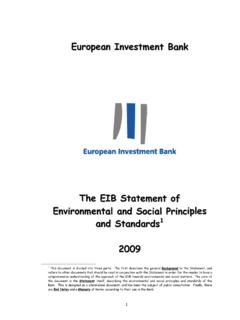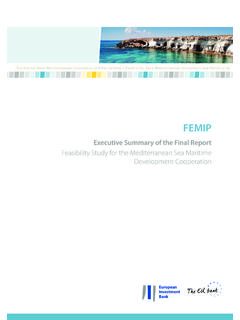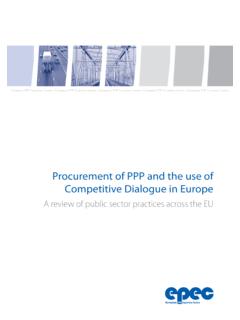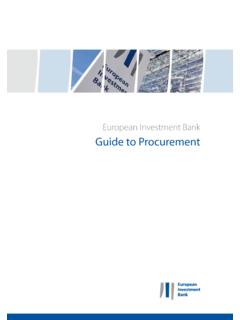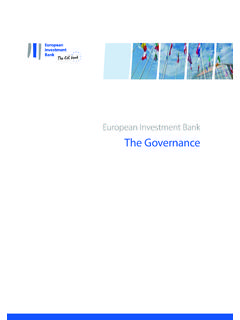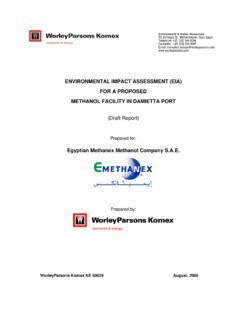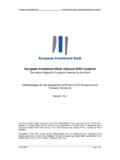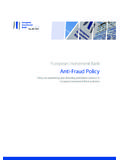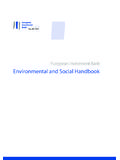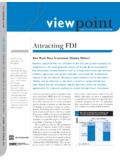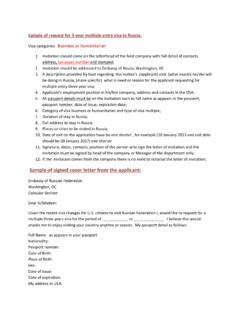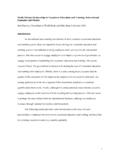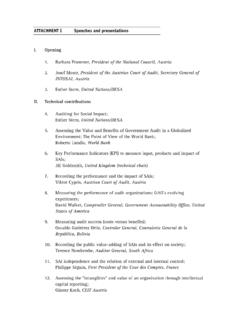Transcription of Small and Medium Entrepreneurship in Russia
1 Small and Medium Entrepreneurship in RussiaNovember 2013 Small and Medium Entrepreneurship in Russia Luxembourg, 7 November 2013 2 Contents 1. Objectives of the study 3 2. Executive summary 3 3. Methodology and assumptions 4 4. Legal framework 5 Description of government policy objectives and instruments for the SME sector 5 Definition of SMEs 6 Legal framework for securitization 7 5. SME sector development 8 Number of SMEs and contribution to employment 8 SME sector dynamics 9 Turnover 10 Employment 11 Breakdown of SMEs by sector 12 Breakdown of SMEs by region 13 Constraints on SME development 14 Need for financial support 15 6.
2 SME Financing: Demand 16 7. Supply of financing to SME, potential market growth and constraints 18 Bank loans 18 Leasing 21 Factoring 22 Microfinance 23 Private equity 24 Constraints 25 8. Modeling of the resources available to banks lending to the SME sector 26 9. Description of key players/potential partners for EIB 27 10. State support for SME 36 SME Bank 36 Regional guarantee funds 37 11. International development institutions activities in Russia 37 International Finance Corporation (IFC) 38 European Bank for Reconstruction and Development (EBRD) 39 KfW Bankengruppe 40 12.
3 EIB support for SME 40 13. EIB Group possible positioning in SME sector in Russia 40 14. Assessment of scenarios in terms of impact on Russian SME sector 41 15. Conclusions 42 16. Appendix 1. Federal law 88-FZ details 44 17. Appendix 2. Statistics on SMEs: regional data 44 18. Appendix 3. Requirements to banks applying for participation in the SME Lending Program of SME Bank 46 19. Appendix 4. The overview of the Russian banking market and its trends 49 20. Appendix 5. Legislative support to SME sector 54 This Report was prepared for the purposes and financed by the European Investment Bank. Ernst & Young (CIS) (Moscow branch office) takes responsibility for the content of this Report solely towards the European Investment Bank. 3 1. Objectives of the study The main objectives of this study are to describe the current position of Small and Medium Entrepreneurship in Russia , to show the market for SME financing and to define the ways European Investment Bank can influence it.
4 The current position of Small and Medium Entrepreneurship includes: evolvement of legal status of SME in Russia contribution of SME to socioeconomic development of Russia SME sector dynamics with respect to different indicators The market for SME financing includes: demand for financing from the borrowers side, including key obstacles supply of financing, including instruments, major players and projections state support and activities of international development institutions The ways European Investment Bank can influence SME financing market include hypotheses and scenarios of possible positioning in the market assessment of those hypotheses/scenarios 2. Executive summary This study was prepared for the European Investment Bank (EIB). The objective of the study is to assess the financing needs of SMEs in Russia and identify the market failures. In addition to senior debt, which is the main instrument currently available to the EIB in Russia , the study also examines the needs for risk-bearing instruments (including subordinated debt and risk capital) as well as SME loan guarantees and other financial instruments, and the contribution of capital markets.
5 The study is based on the best available and actual data from the following sources: state statistics, state SME full coverage review 2010, reviews of analytical agencies, industrial surveys, surveys of non-state SME associations, companies financial reports, national enterprises database SPARK, EY research studies and proprietary data bases on banking and SME sectors. The SME sector in Russia has steadily grown since 2005, both in terms of SME number and turnover. Nevertheless, the current share of SME in GDP is estimated at 20-25%, which is not only significantly lower than in developed countries, but incomparable to developing ones as well. This fact, as well as the SME regional and industrial structure, shows the underdevelopment of the sector. Industrial structure of Russian SME segment indicates the underdevelopment of certain industries: more than half (57%) of SME turnover falls within the trade sector.
6 Manufacturing accounts for of total turnover, construction and real estate Together these four sectors amount to approximately 90% of SME turnover. The share of every other sector does not exceed 5%. Regional structure of Russian SME segment demonstrates uneven distribution of SME turnover: approximately 80% of SME turnover is located in the European part of Russia , with 48% of total SME turnover coming from the Central and North West Federal Districts. Additionally, SMEs located in Moscow and Saint Petersburg generate 18% and 7% of total turnover, respectively. One of the key constraints to SME development is low availability of financing. Further analysis identified key groups of SME requiring financial support with total number of SMEs in these groups being over 1 mln.: mature industrial (including innovative) SMEs un-bankable developing SMEs1 beginner individual entrepreneurs2 1 SME`s which have no access to bank financing due to various obstacles, for example, high borrowing cost, lack of collateral etc.
7 2 Persons who commence their own business - start-up project 4 Key financial instruments available on the Russian SME market are: bank loans, leasing, factoring, microfinance, private equity. The most popular source of SME financing is bank loan (27%). Second and third by popularity are borrowings from relatives and friends (19%) and trade credit (17%). Leasing, factoring and others are not widely popular. Most common purposes of using external financing are investment purposes (equipment, transportation vehicles, etc.) and working capital - 55% and 47% respectively. None of the other purposes exceeded 10%. The share of total SME financing by institutional investors and total number of SME organizations will increase in the future. The main driver of this is the political will of the state. SME business in Russia is one of top priorities for the Russian government.
8 Doing Business research was chosen as an indicator of SME sector development. According to the most recent report Doing Business 2014, the Russian government measures implemented in 2012-2013 helped Russian Federation to move up 20 positions, one of the top-5 biggest improvements in 2013. The goal set by the government is to reach the top-20 by the year 2018. State support for Small and Medium businesses is conducted through a variety of channels: SME Bank (total support of bln.), regional guarantee funds ( bln. guarantees), regional governments (EUR451 mln. of support in 2013), etc. The significance of SMEs for the Russian economy also attracts international players to the sector. Key international development institutions acting in this field in Russia are European Bank for Reconstruction and Development (investment portfolio of bln), International Finance Corporation (invested bln since 1993) and KfW Bankengruppe (targeted loans of EUR200 mln) Despite steady growth of SME financing market recently, the comparison of SME financing market figures of Russia with Europe shows considerable potential for growth of banking and nonbanking financing to SMEs.
9 The majority of SME financing markets in Russia are in the developing or emerging stage and there is potential for international financial institutions to make a considerable impact on the economy by enhancing financial services to the SME sector. Accordingly, EIB faces a set of scenarios, which imply various degrees of involvement and commitment to the SME sector in Russia . The chosen scenario will also define the degree of impact EIB will ultimately have on the Russian SME sector. 3. Methodology and assumptions The report is based on the desk research and analysis of information and data available from open sources, EY project experience as well as the opinion expressed by EY internal and external experts. The following sources of information were used for different sections of the report: Legal framework: federal laws on Small and Medium Entrepreneurship , mortgage-backed securities and bill on securitization of financial assets; information on volumes of issued MBS is taken from , data on new mortgage loans from.
10 Information provided by the Association of regional banks SME sector development: the information is taken from annual statistical observations Small and Medium Entrepreneurship in Russia , including the complete statistical observation of 2010 SME financing demand: the information is taken from 2012 OPORA Regional Index (this report assesses conditions of SME development) SME financing supply: the information is taken from Russian analytical agencies and Russian Venture Capital Association Information on key players in the Russian SME lending market is taken from publicly available sources, including the Central Bank of Russia (CBR) and IFRS reports of these organizations Information on state support to SME is taken from research agencies and the state-controlled SME Bank, subsidiary of Vnesheconombank (VEB) Information on support of international development institutions is taken directly from these institutions All currency values in the document are given in euros and sometimes in rubles.
